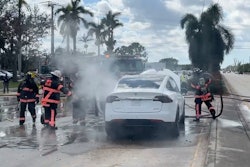In the early days of cars, one of the significant issues with introducing the internal combustion engine to replace horses was that the reduction in manure created in cities impacted the availability of fertilizer for rural farmers.
I am fairly sure that ramification was not considered in Henry Ford’s business plan for the Model A. In fact, the entire system for feeding, maintaining and servicing horses and horse-drawn wagons was severely impacted by the introduction of internal combustion engines (ICE). I read about this in a 1930 Saturday Evening Post article by Alexander Winton, who founded the Winton Motor Carriage company in 1896. Apparently, manure doesn’t always happen, and that has ramifications too.
There is a fascination with hyping electric vehicle fires in social media and news articles as if they are frequent things to worry about. We seem to thrive on “dirty laundry,” as Don Henley sang. The most recent wave of coverage came out of the aftermath from hurricane Ian, where areas devastated by the storm and flooding saw some electric cars catch fires. EV giants like Tesla, GM, Ford, etc. are on a learning curve with production vehicles.
Ian provides a great deal of field experience and feedback on the need to design cars for safe extended periods of saltwater submersion. The point is that turning your new EV into a submarine was probably not an early EV operational design domain for the engineers. Not so that you can reuse the EV after it’s been swimming in the Gulf for a week, but so it does no harm as the doctor’s hippocratic creed states.
The trucking industry and its lawyers abhor the word “fire,” preferring “thermal event” or other terminology. I have spoken in public and written that all vehicles will burn given the wrong conditions. EVs in general are as safe or safer than gasoline and diesel vehicles. For background on that, see the section conveniently titled Fire in NACFE’s Guidance Report, Medium-Duty Electric Trucks — Cost of Ownership.
Engineering is about doing something that has not been done before. There is a learning curve with all technologies and it is fundamental to how things are made better. Bridges, engines, buildings, airplanes, computers, clothes, shoes, medicines, text books have all benefitted greatly learning from failures. Even storied high reliability technologies like nuclear power and space systems see failures that lead to much improved new systems.
I still recall my first-year college Introduction to Engineering class where required reading was books about learning from failure. I spent time supporting NASA’s space shuttle program following the Challenger accident and saw what a tremendous example that became of learning from failure. Still, perfection eluded them and the later Columbia accident investigation highlighted more learning opportunities.










